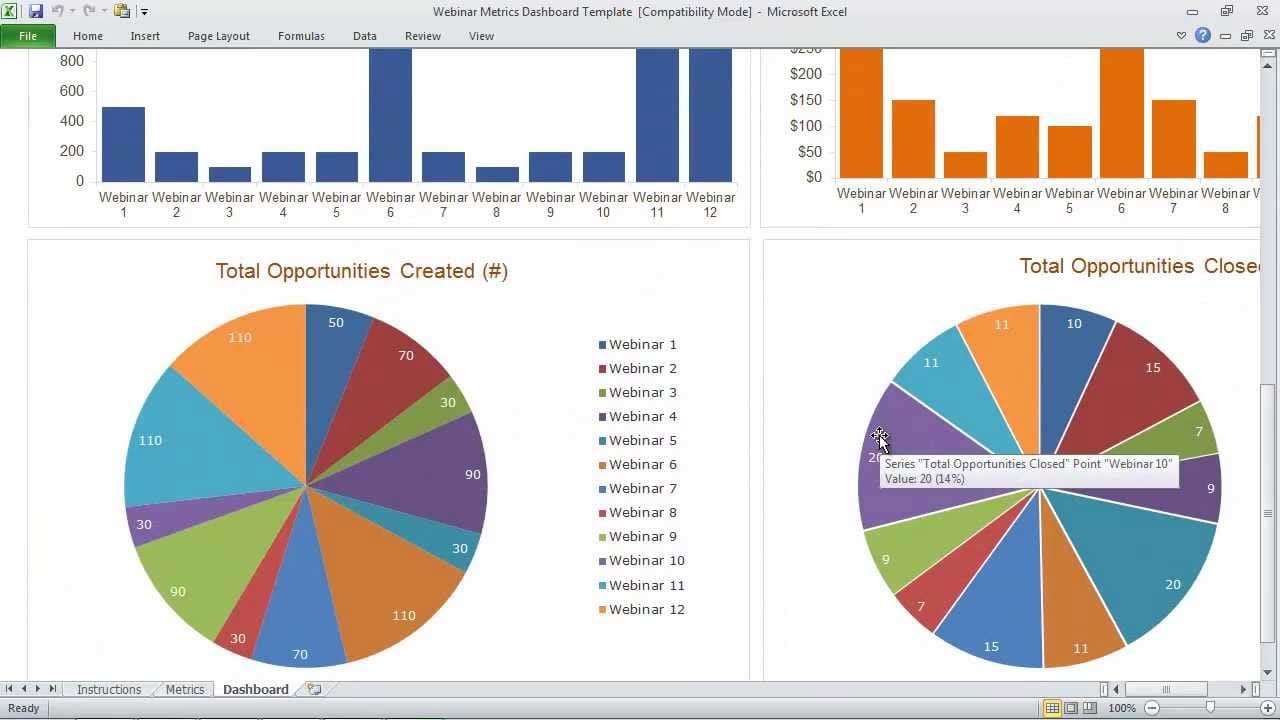Webinar Analytics And Metrics: Tracking Success And Optimizing Future Launches

Are you trying to track the success of your webinars and optimize future launches? Look no further! In this article, we will explore the world of webinar analytics and metrics, providing you with valuable insights and strategies to measure the effectiveness of your online events.
From tracking attendee engagement to analyzing conversion rates, we will delve into the key metrics that can help you gauge the impact of your webinars and make data-driven decisions for future launches. So, grab a cup of coffee and let's dive into the fascinating world of webinar analytics!
Understanding Webinar Analytics and Metrics
Webinar analytics and metrics refer to the data and measurements gathered from webinars to analyze their performance and effectiveness. These metrics provide valuable insights into how well the webinar was received by the audience, the level of engagement achieved, and areas for improvement. By tracking webinar analytics and metrics, you can make data-driven decisions to optimize future webinar launches and ensure their success.
Importance of Webinar Analytics and Metrics
Webinar analytics and metrics play a crucial role in understanding the impact and success of your webinars. They provide concrete data and measurable results that help you assess the effectiveness of your webinar strategy. Without these analytics, you would be relying solely on subjective feedback or assumptions, which can lead to inaccurate conclusions and missed opportunities for improvement.
Overview of Webinar Analytics and Metrics
Webinar analytics and metrics encompass various aspects of a webinar's performance, ranging from registration metrics to post-webinar engagement. By analyzing these metrics, you can gain valuable insights into attendees' behavior, level of engagement, and overall success of the webinar. Key webinar metrics to track include registration metrics, engagement metrics, survey and feedback metrics, and post-webinar metrics.
Key Webinar Metrics to Track
Registration Metrics
Registration metrics focus on analyzing the number of registrations, conversion rates, and sources of registrations for your webinar. These metrics provide insights into the effectiveness of your marketing efforts and help you identify which channels are driving the most registrations. By tracking registration metrics, you can optimize your registration process and improve the number of qualified leads.
Engagement Metrics
Engagement metrics measure the level of interaction and participation from attendees during the webinar. These metrics can include the number of questions asked, polls answered, and chat messages sent. By tracking engagement metrics, you can assess the effectiveness of your webinar content and identify areas where attendees may have lost interest or disengaged. This information can be used to make improvements in future webinars and increase overall engagement.
Survey & Feedback Metrics
Survey and feedback metrics involve gathering feedback from attendees after the webinar. This could be in the form of post-webinar surveys, ratings, or comments. These metrics provide insights into attendees' satisfaction, the clarity of the content, and any areas for improvement. By leveraging survey and feedback metrics, you can gain a deeper understanding of how your webinar was received and make data-driven decisions to enhance future webinar experiences.
Post-Webinar Metrics
Post-webinar metrics focus on tracking attendees' actions after the webinar, such as downloading additional resources, signing up for newsletters, or making a purchase. These metrics help determine the overall success of the webinar in achieving its intended goals, whether it be lead generation, sales conversions, or knowledge sharing. By analyzing post-webinar metrics, you can assess the impact and effectiveness of your webinar beyond the live session.
Importance of Tracking Webinar Success
Tracking webinar success through analytics and metrics is vital for several reasons.
Assessing the Effectiveness of the Webinar
Webinar analytics allow you to objectively evaluate the success of your webinar by measuring the metrics that matter. By tracking registration rates, engagement levels, and post-webinar actions, you can determine whether your webinar met its objectives, such as generating leads or increasing brand awareness.
Identifying Gaps and Shortcomings
Analyzing webinar metrics helps you identify areas where your webinar may have fallen short. By pinpointing low engagement levels, high drop-off rates, or low post-webinar conversions, you can identify gaps in your content or delivery that need improvement. This allows you to refine your strategy and create more impactful webinars in the future.
Understanding Audience Behavior
Webinar analytics provide valuable insights into your audience's behavior and preferences. By studying engagement metrics and survey feedback, you can gain a deeper understanding of what resonates with your audience, their pain points, and their interests. This knowledge allows you to tailor future webinars to better meet their needs and expectations.
Improving Future Webinar Launches
Tracking webinar success empowers you to make data-driven decisions and optimize future webinar launches. By analyzing registration metrics, engagement levels, survey feedback, and post-webinar actions, you can refine your marketing strategies, improve content delivery, and provide a better overall experience for your attendees.
Analytics Tools for Webinars
To effectively track and analyze webinar analytics and metrics, utilizing the right analytics tools is essential. Here are some key considerations when selecting webinar analytics software:
Best Software for Webinar Analytics
When choosing webinar analytics software, it is important to prioritize tools that offer comprehensive tracking functionalities and robust reporting capabilities. Some popular options include GoToWebinar, Zoom, Webex, and BlueJeans. These platforms provide features for tracking registration metrics, attendee engagement, survey feedback, and post-webinar actions.
Features to Look for in a Webinar Analytics Tool
When evaluating webinar analytics tools, look for features such as real-time data tracking, customizable reports, integration with marketing automation platforms, and advanced analytics capabilities. These features allow you to gather actionable insights, automate processes, and optimize your webinar strategy effectively.
Using Webinar Analytics Software
Once you have selected an analytics tool for your webinars, it is important to leverage its features effectively. Ensure that the software is properly integrated with your webinar platform and marketing automation tools. Set up accurate tracking parameters and establish a reporting system to regularly monitor and analyze the data. Remember to keep your analytics goals in mind and align the metrics you track with your webinar objectives.
Analyzing Registration Metrics
Importance of Registration Metrics
Registration metrics provide valuable insights into the effectiveness of your webinar marketing strategy. By tracking metrics such as the number of registrations, conversion rates, and the sources of registrations, you can evaluate the success of your promotional efforts. These metrics also help you understand the quality and relevance of your leads, allowing you to tailor your messaging and targeting.
Key Factors in Registration Metrics
When analyzing registration metrics, consider factors such as the total number of registrations, registration conversion rates, the proportion of registrations from different marketing channels, and the quality of the leads generated. By evaluating these factors, you can identify areas that need improvement and optimize your registration process to attract more qualified leads.
Optimizing Registration Process with Analytics
Leverage the data from registration metrics to optimize your registration process and increase conversions. Analyze which channels are driving the most registrations and focus your efforts on those channels. A/B test different registration forms and landing pages to optimize conversion rates. Collect feedback from registrants to understand any pain points during the registration process and make necessary improvements to enhance the user experience.
Monitoring Engagement Metrics
Defining Engagement Metrics
Engagement metrics measure the level of interaction and participation from attendees during the webinar. These metrics provide insights into the effectiveness of your content delivery, attendee interest, and overall engagement. Key engagement metrics to monitor include the number of questions asked, polls answered, chat messages sent, and average duration of attendance.
Tools and Techniques for Measuring Engagement
To measure engagement during webinars, utilize features provided by your webinar platform, such as real-time polling, chat functionality, and Q&A sessions. These tools allow attendees to actively participate and provide valuable feedback. Additionally, you can monitor engagement metrics by analyzing post-webinar surveys, evaluating attendee feedback, and reviewing metrics provided by webinar analytics software.
Tips to Increase Engagement in Future Webinars
To enhance engagement in future webinars, consider the following tips:
- Tailor content to the needs and interests of your audience.
- Engage attendees through interactive elements such as polls, quizzes, and discussions.
- Encourage active participation with Q&A sessions and live chat.
- Keep the webinar concise and engaging to maintain attendee interest.
- Use visual aids, such as slides or videos, to enhance the presentation.
By implementing these strategies and monitoring engagement metrics, you can create a more interactive and engaging webinar experience for your audience.
Leveraging Surveys and Feedback Metrics
Importance of Audience Feedback
Audience feedback is a valuable source of insight for improving future webinars. By collecting feedback through surveys and ratings, you can understand attendees' satisfaction levels, identify areas of improvement, and gather suggestions for future webinar topics or formats. Feedback metrics provide a direct line to your audience, enabling you to enhance their experience and meet their expectations.
How Surveys Increase Engagement
Surveys play a vital role in increasing engagement during webinars by actively involving attendees and giving them a voice. By including strategic questions that prompt attendees to provide feedback or insights, you encourage active participation and make attendees feel valued. Surveys also provide an opportunity for attendees to share their thoughts and opinions, resulting in a more engaging and interactive webinar experience.
Processing Feedback for Webinar Improvement
To effectively process feedback and improve future webinars, follow these steps:
- Analyze survey responses and identify common themes or areas for improvement.
- Prioritize feedback based on its relevance and potential impact on attendee satisfaction.
- Use feedback to make data-driven decisions on content, delivery, and format improvements.
- Communicate changes made based on feedback to show attendees that their input is valued.
- Monitor subsequent webinar analytics and metrics to assess the impact of the improvements made.
By actively incorporating audience feedback into your webinar strategy, you can continuously improve the quality and relevance of your webinars.
Making Sense of Post-Webinar Metrics
Analyzing Post-Webinar Engagement
Post-webinar engagement metrics provide insights into attendees' actions and behaviors after the webinar. Key post-webinar engagement metrics to track include the number of downloads of additional resources, sign-ups for newsletters, or conversions into paying customers. By analyzing these metrics, you can determine the effectiveness of your webinar in achieving its desired outcomes and identify areas for improvement.
Tracking Follow-up Actions
Monitoring post-webinar metrics allows you to track and analyze attendees' follow-up actions. By tracking metrics such as resource downloads, newsletter sign-ups, or purchases, you can assess the impact of your webinar beyond the live session. Tracking follow-up actions enables you to nurture leads, measure conversions, and tailor future marketing strategies accordingly.
Assessing Overall Webinar Success
Post-webinar metrics, when analyzed collectively, provide a comprehensive understanding of the overall success of your webinar. By evaluating engagement metrics, survey feedback, and post-webinar actions, you can assess the impact, effectiveness, and return on investment of your webinar. This assessment helps you make data-driven decisions for future webinar launches and optimize your webinar strategy.
Optimizing Future Webinar Launches through Metrics
Using Analytics to Improve Your Webinar Strategy
Leveraging webinar analytics allows you to continuously improve your webinar strategy by making data-driven decisions. By analyzing metrics related to registration, engagement, feedback, and post-webinar actions, you can identify areas for improvement, refine your content and delivery, and create more impactful webinars. Regularly tracking and assessing these metrics ensures your webinars evolve and align with the needs and expectations of your audience.
Creating a Seamless Experience for Attendees
Analyzing webinar analytics not only helps improve the content and delivery of your webinars but also ensures a seamless experience for attendees. By understanding registration metrics, you can optimize the registration process and make it easy for attendees to sign up. By monitoring engagement metrics, you can pinpoint areas that may cause attendee disengagement and take steps to rectify them. By leveraging feedback metrics, you can actively involve attendees and address their needs and expectations. Together, these efforts create a seamless and engaging experience for your attendees.
Planning for Future Webinar Content
Webinar analytics provide valuable insights for planning future webinar content. By understanding audience behavior, engagement levels, and interests, you can identify trending topics or pain points that can be addressed in future webinars. Analyzing post-webinar metrics can also give you an understanding of the topics or resources attendees are most interested in, helping you plan relevant and valuable content for your audience.
Case Studies of Successful Webinar Analytics Use
Brands that Efficiently Use Webinar Analytics
Several brands have successfully utilized webinar analytics to enhance their webinar performance. For example, Company XYZ increased attendee engagement by incorporating real-time polls and Q&A sessions based on their analysis of engagement metrics. Brand ABC improved their webinar registration conversion rates by optimizing their registration process using insights from registration metrics.
How Metrics Transformed Their Webinar Performance
By analyzing webinar analytics and metrics, these brands were able to identify gaps in their webinar strategy and make data-driven changes. They tailored their content to the needs and interests of their audience, increased attendee engagement through interactive elements, streamlined their registration process, and improved the overall webinar experience. By leveraging webinar analytics, these brands were able to transform their webinar performance and drive better results.
Lessons from Their Strategies
The success stories of these brands highlight the importance of leveraging webinar analytics for optimizing webinar performance. By analyzing metrics from registration to post-webinar engagement, brands can identify areas for improvement and make data-driven decisions. Some key lessons from their strategies include:
- Regularly track and analyze webinar metrics to identify areas for improvement.
- Tailor webinar content and format based on audience preferences and interests.
- Actively involve attendees through interactive elements like polls and Q&A sessions.
- Optimize the registration process to increase conversion rates and attract qualified leads.
- Gather and incorporate feedback from attendees to improve the webinar experience.
By applying these lessons and continuously refining their webinar strategies based on webinar analytics, brands can drive better webinar performance and achieve their desired outcomes.
In conclusion, webinar analytics and metrics provide valuable insights into the effectiveness and success of your webinars. By tracking registration metrics, engagement metrics, survey and feedback metrics, and post-webinar metrics, you can assess the impact of your webinars, identify areas for improvement, and optimize future webinar launches.
Leveraging analytics tools and analyzing metrics allow you to make data-driven decisions, create a seamless experience for attendees, and continuously improve your webinar strategy. By learning from successful case studies, you can apply their strategies and lessons to drive better webinar performance and achieve your webinar goals.
We hope you find your next favorite thing from the list /information we provided! Each product was independently selected by our editors.
By the way, NextBestChoice may collect a share of sales or other compensation from the links on this page if you decide to buy something at no extra cost to you (that's how we stay in business).
Reviews have been edited for length and clarity. Enjoy finding your next best buy ever!

